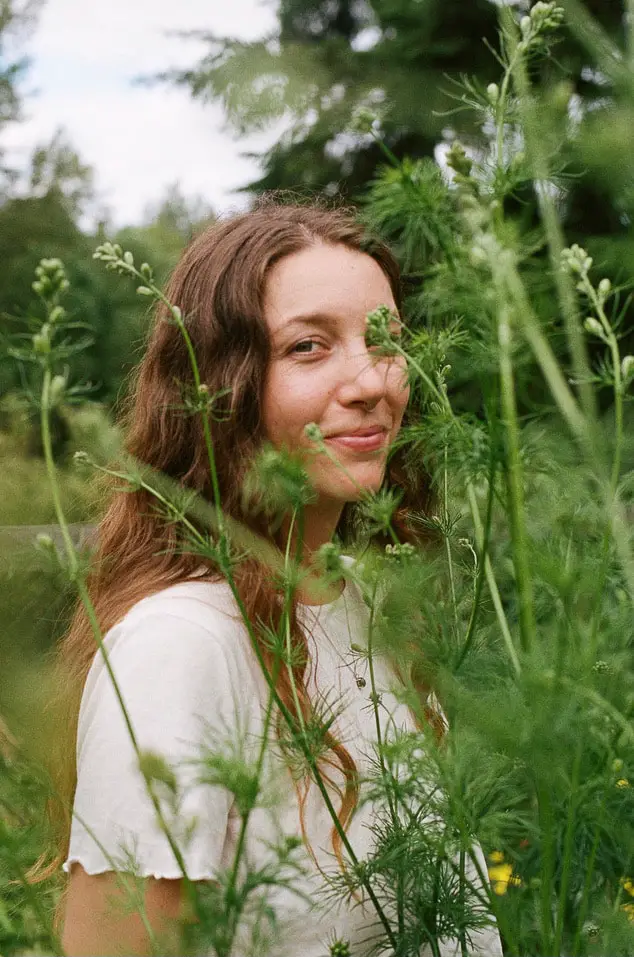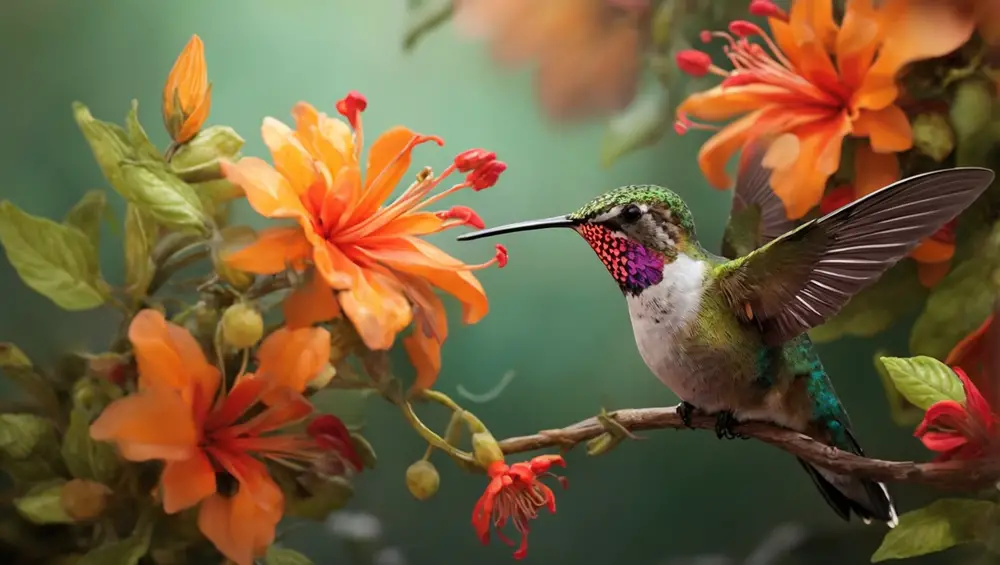Learning how to attract hummingbirds to your garden is a great way to enjoy these unique birds. They also offer many beneficial qualities. They are important pollinators, have large migrational patterns, and are beautiful to look at!
There are a number of ways to attract these beautiful birds to your garden space. In this article, you will find everything you need to know to attract and support them. This includes the best choices for plants, care, diet, eco-friendly pesticide alternatives, and even a DIY nectar recipe.
Understanding Hummingbirds
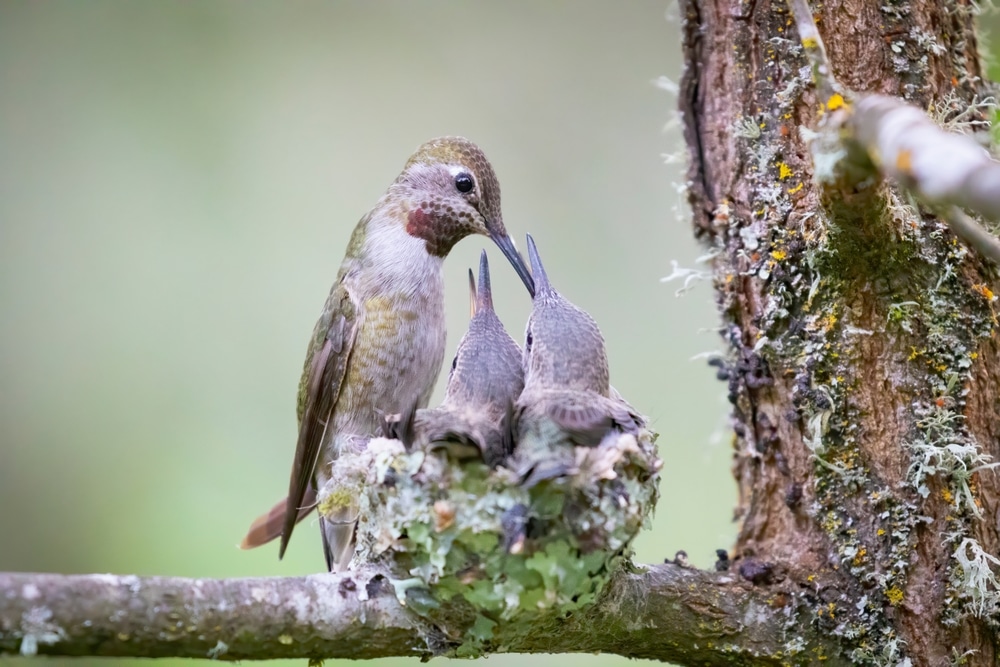
Hummingbird Habitat
A general question often asked is where do hummingbirds live?
They are native to North, South, and Central America. The majority of species reside in South America.
Their natural habitat and site preferences range from high altitude to low valleys. Some species can be found in alpine ecosystems, while others can be found in open valleys, deciduous forests, and even in your backyard garden!
The natural habitats of these little birds generally include high perching opportunities. This is because they are often highly territorial and therefore require higher areas to keep an eye on their terrain, seek out mates, and chase off any potential competitors.
Hummingbird Nesting Habits
Where Do Hummingbirds Nest?
Depending on species, they can be picky in their nesting site selection. Ideal nesting spots are covered areas like deciduous forests. Best nest locations are typically by water and easily accessible to food sources like flowers!
They prefer cool, sheltered locations to help aid in camouflaging the nest and to support the health of the chicks. They build their nests between 10 to 90 m off of the ground.
How Do Hummingbirds Build Nests?
Females will build their nests before the mating season begins. Nest construction typically takes about one week. Nest sizes and materials used are dependent on species. Generally, nests are small, compact and no bigger than 1 inch in diameter.
Nest materials include but are not limited to small twigs, leaves, lichen, moss, feathers, plant matter, and even spider silk! Spider silk helps to hold these soft, flexible nests together.
The nests are flexible and mold and shape as the chicks grow! Because of this, hummingbirds will not use the same nests year after year.
How Many Eggs Do Hummingbirds Lay In A Season?
Clutch sizes range from 1-3 eggs. Females lay between 1 to 2 broods in a season. Nesting season start dates depend on the species.
Typically, in warmer areas, the season can start as early as March, while cooler climates see nesting season begin around July.
Hummingbird Nesting Challenges
Some nesting challenges include:
- Delicate nests: Nests may be soft and flexible, but the delicate material used to create them can mean they are quite fragile. Nests can fall apart easily if exposed to weather like wind and rain.
- Predators: Their eggs and hatchlings are susceptible to predators like snakes and other birds.
The Myth Of Hummingbird Houses
A question often asked is do hummingbirds use birdhouses?
The truth is they do not nest in them. Even the open-concept ones you can buy in stores or online are unsuccessful.
This is because they are not cavity-nesting birds. This means that the ideal nesting spots are located in the forks of tree branches, and under shelter but out in the open.
The best way to attract them is to create a bird-friendly garden. This means growing nectar-rich plants, native flowers, and pollinator plants to attract insects that provide a food source for the birds. This also means adding habitat features like feeders, a consistent water source and choosing organic gardening methods.
Up next we will deep dive into creating a friendly environment so you can learn how to create a Hummingbird haven in your garden. This includes the importance of:
- Feeders
- The best placement for feeders
- The best plants
- The benefits of organic gardening
- And more!
Create a Hummingbird-Friendly Environment
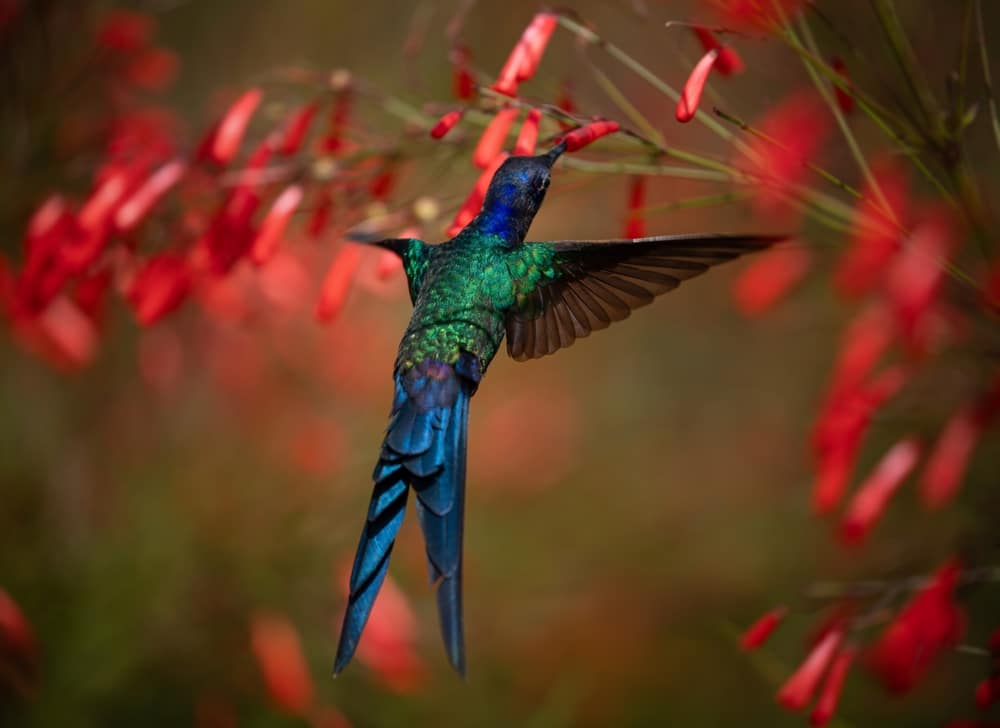
What Do Hummingbirds Eat?
To attract hummingbirds to your garden, it’s important to understand what they like to eat. Their diet consists mostly of nectar as their primary food source. They also get protein from small insects like flies and small beetles.
Do Hummingbirds Eat Wasps?
No, even though they eat small insects, they do not eat bees and wasps. Although they have been seen chasing them away from feeders and food sources like pollinator plants.
Hummingbird Feeders

Why Are Hummingbird Feeders Essential?
They are essential because they provide a consistent food source throughout the year.
The Importance Of Hummingbird Feeders
Providing a food source needs to be consistent. The reliable food source aids in successful overwintering for birds that spend the winters in your area. These feeders can also supply an additional food source for when they are migrating or during nesting season, ensuring they have more than enough sustenance during important times in their yearly cycle.
Feeder Placement Tips
There are many benefits of feeders. Outlined below are some tips on the significance of feeders and where to place them.
- Amount: Having many feeders will attract lots of hummingbirds BUT! This does not create a sustainable environment to build nesting sites. This is due to their territorial personalities.
- Spacing: Make sure feeders are placed at a far enough distance away from one another. This will ensure that each bird will not see one another and that everyone will get their fair share.
- Height: The best feeder placement should be positioned high enough that it is safe from predators. Feeders should be sheltered from wind, rain and direct sunlight. Proper feeder placement is important as it keeps the birds safe and fed!
- Seasonal: If you have hummingbirds in your area that stay year-round, leave your feeders up through the winter! This can ensure a food source in times when not as many flowers are in bloom and sustenance may be difficult to find.
Homemade Hummingbird Nectar Recipe
Making your own homemade nectar recipe is a simple and economical approach to creating a year-round food source for these fascinating birds. The best recipe for home-made nectar is so simple!
Here’s how to make it:
- Mix 1 cup (250 grams) of white refined sugar and 4 cups (0.94 liters) of water in a pot
- Place on the stovetop and turn the heat on high until boiling
- Stir until the sugar is fully dissolved
- Remove from the stove
- Let cool before pouring into the feeder
This DIY nectar is fun to make with the entire family, then you can all enjoy watching them visit your feeders.
Hummingbird Feeder Maintenance
It’s important to keep your feeders clean. Change nectar every 3 days or so. Never leave nectar out in the feeder for more than 1 week.
Maintaining feeders helps to mitigate against bacterial growth that can kill hummingbirds.
How To Clean Hummingbird Feeders
- Discard any remaining nectar
- Soak feeder in a solution of hot water and dish soap
- Use a bottle brush and scrub inside and out of feeder
- Rinse the feeder with cool water
- Either let the feeder air dry or dry with a towel before refilling.
Feeder Cleaning Tips!
- You can also use a one-part vinegar solution to two-part water to soak your feeder for that extra clean feeling.
- Some feeders may be dishwasher-safe!
Best Plants For Hummingbirds
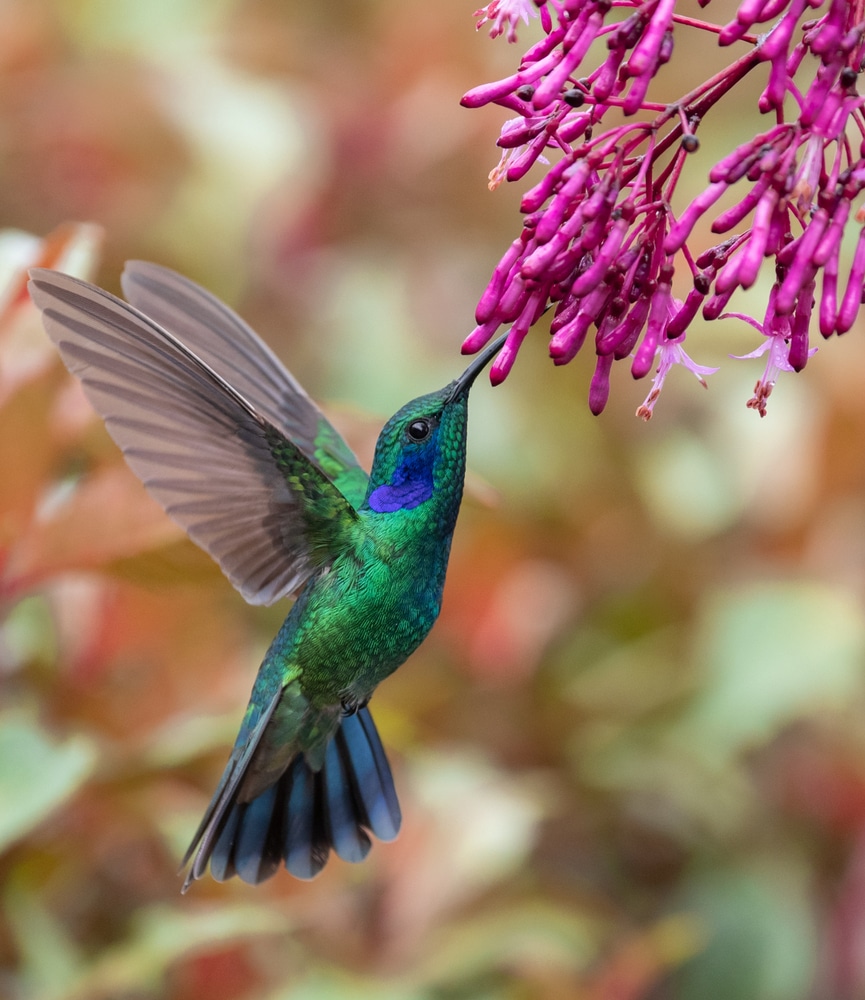
The best way to attract these little birds and to create a hummingbird garden is to plant a diversity of plants with different bloom times. This provides a consistent food source for them throughout the entire growing season.
Plants That Attract Hummingbirds
Below are the top flowers I recommend. All of these plants help in creating a nectar-rich garden.
- Hibiscus
- Columbine
- Fuchsia
- Delphinium
- Bee Balm
- Hummingbird Mint
Hummingbird Garden Tips
- Plant trees and shrubs: This helps in creating nesting sites for them
- Create a nectar-rich garden: The best plants are ones full of yummy nectar
- Hibiscus: Hummingbirds love hibiscus! They are drawn to the colors and are high-producing nectar-rich plants
- Choose native plants!
- Perching opportunities: Choose tall plants for them to perch and rest on. This also gives them plenty of opportunity to survey their kingdom
- Choose colorful plants: These little birds are attracted to brightly coloured flowers like red, purple and orange
Hummingbird-friendly plants help create an atmosphere that is beneficial not only for these lovely birds but also for many beneficial insects that can help pollinate your garden space and create a biodiverse landscape.
Importance Of Native Plants
Native plants contribute to a large portion of their food source and nectar intake. By cultivating native plants to your garden space you are aiding in the restoration of important ecosystems and creating biodiverse landscapes for them and other local birds and bees.
Why use native plants for hummingbirds?
Native plants have adapted over millennia to the growing climate of the regional area they are found in. Native plants have evolved alongside the native birds and bees that rely on them, creating a symbiotic relationship between the two.
Additional benefits include:
- Drought tolerant
- Low maintenance
- Cold-hardy
- Beautiful!
These resilient plants will attract more bird species and pollinators to your garden than a mass of non-native ornamental plants.
Native plant gardening for hummingbirds helps to steward the land and can be educational for the entire family. Teach your children about rewilding landscapes by showing them how beautiful and biodiverse your backyard can become.
Hummingbird Water Source
Why Do Hummingbirds Need Water?
Just like most living creatures on the planet, hummingbirds require water to survive. Most of their need for water comes from nectar, but that doesn’t mean they don’t benefit from a consistent water source to drink from! A reliable water source can help supplement daily water intake when flowers may not be in bloom.
They also enjoy a good bath! The best water sources can look like bird baths or fountains. They are especially attracted to running water, so a tiered water fountain would make a nice option for a water feature.
When creating a safe water source for hummingbirds, make sure the bird baths are low-lying so they can safely drink without drowning. Provide perching areas to also contribute to a safe water source.
Pesticide-Free Zone
Pesticides affect not only insects and hummingbirds but other animals as well.
First, these chemicals reduce the number of bugs that this bird and other important birds rely on as a food source. They can also absorb these chemicals by eating infected bugs. This is called bioaccumulation. This harms hummingbirds and in turn animals that may eat the birds too. Even your pet cat can ingest harmful chemicals through bioaccumulation if they catch and eat infected bugs or birds.
Hummingbirds are also affected by pesticides through the plant’s absorption of these chemicals. When the birds drink nectar from contaminated plants they internalize these chemicals and it affects them negatively. Research shows that pesticides can reduce their metabolism within hours of ingesting contaminated nectar.
Studies show that pesticides like imidacloprid can be found in plants even after a year of spray application. This means that hummingbirds can absorb these chemicals even years after they have been sprayed.
Benefits Of Organic Gardening
Why Go Organic For Hummingbirds?
Due to the negative impact that pesticides have on entire ecosystems, organic gardening is an easy answer to a large problem. The benefits of organic gardening outweigh the need to remove certain insect pests from the garden space. I suggest incorporating these organic gardening tips:
- Try forms of biological mitigation techniques, like ladybugs for issues with aphids or ducks for slug problems!
- Use organic fertilizers and bone meal to feed plants.
- Try vermicomposting with red wigglers and make your homegrown compost tea.
- Use a row cover to protect veggies from cabbage moth larvae and other insects that might munch on your veggies.
- Learn to coexist with all forms of nature. It’s so important to understand that we make or break healthy ecosystems. Let’s respect all forms of bugs, birds and animals.
Protect Hummingbirds
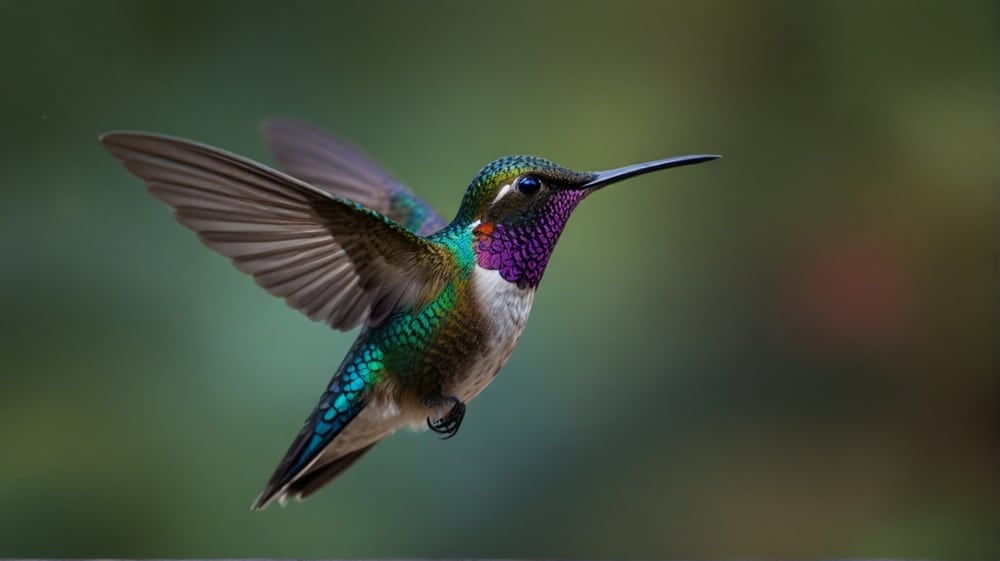
Hummingbird Conservation
Hummingbirds are important pollinator species. They help to pollinate many native wildflowers. They contribute to a beneficial and fruitful ecosystem and add so much joy to any garden space.
Unfortunately, their populations are in decline. The IUCN has all species of hummingbirds listed as either endangered or vulnerable.
Threats to populations include:
- Habitat loss
- Climate change
- Pesticide use
These birds are sensitive to environmental change and rely on native plants and insects as a food source.
There are many benefits to protecting and conserving populations. These speedy little birds are fascinating creatures and have evolved to coincide with certain native plants that specifically require their pollination. It’s important to support their conversation to keep our ecosystems in balance as they help contribute to a healthy and thriving planet.
Ways To Help Protect Hummingbirds
There are many ways to help protect and support their conservation.
One way is through habitat restoration and cultivating hummingbird-friendly gardens. This means planting native plants, going organic, and adding feeders and reliable water sources for these special birds.
Another way to help protect these beautiful birds is to donate to local organizations that help conserve these beautiful birds as well as other vulnerable bird species.
Contributing to population surveys and bird counts like Feederwatch, and eBird is a fun and educational way to help all types of birds. You can also become a citizen scientist!
With your help, we can all do our part to help hummingbirds survive and thrive.
